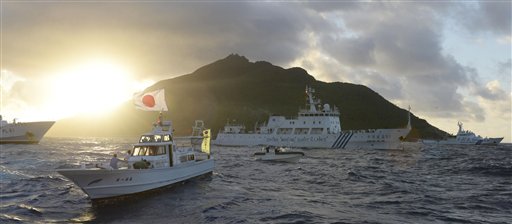Japan and China trade sharp words over islands

A Chinese surveillance ship, rear center, sailed near Uotsuri island in Japanese, or Diaoyu Dao in Chinese, the biggest island in the disputed Senkaku Islands, or Diaoyu Islands on Juy 1. (AP Photo/Kyodo News)
BEIJING » In an unusually vigorous rebuttal to Japan’s latest accusations that China is using aggressive tactics to expand its maritime reach, the Chinese Defense Ministry said Japan was undermining stability in the region with its claims to disputed islands known as the Diaoyu in China and the Senkakus in Japan.
The Defense Ministry, which issued its statement on Friday, rarely mentions another country by name, Chinese experts said.
The Chinese military is “strongly discontented and resolutely against” the accusations in the Japanese white paper, an annual assessment of the country’s military situation, a spokesman for the defense ministry, Geng Yansheng, said in a statement.
The heated exchange, which started with the Japanese government’s defense paper issued last week, underlined the intensifying distrust between the two nations, both of which dispatch ships and planes to patrol the islands in the East China Sea. Japan has administered the islands for decades.
Experts said the strongly worded statements on both sides may be a precursor to worsening dynamics between the two countries as they try to outmaneuver the other in the region and talk each other down in diplomatic settings. The enmity is partly historical, driven by grievances from imperial Japan’s land grabs in the late 1800s and early 1900s, and from World War II.
Japan’s purchase of some of the uninhabited islands in September stirred outrage in China, where many see them as Chinese territory that remains in Japan’s hands from its foray into empire-building. Japan says China started showing interest in the islands only in recent decades, after scientists found evidence of nearby undersea oil and natural gas deposits.
Don't miss out on what's happening!
Stay in touch with breaking news, as it happens, conveniently in your email inbox. It's FREE!
The latest battle of words comes as China says it has gained ground in its claims to the islands with almost continuous maritime patrols since September.
In Japan, Prime Minister Shinzo Abe’s conservative party appears headed for an electoral victory in upper-house elections this month that would enable the nationalistic leader, if he chooses, to try to alter the anti-war constitution so that Japan could maintain a regular army rather than a self-defense force. That would incense China and drastically alter the regional security architecture that is already shifting under the weight of China’s growing military strength.
Whether Abe decides to aim for such far-reaching change or not, China is watching closely as the Japanese leader forms new defense guidelines that will almost certainly result in a more robust posture by the Japanese military.
The Abe government has already announced a 0.8 percent increase in military spending, the first rise in 11 years, but still a small fraction of the gains by the Chinese military over the past decade.
The Japanese white paper was the “toughest” ever on China, and reflected the intense concern about China’s military gains, particularly by the rapidly modernizing navy, said professor Hu Lingyuan, the deputy director of the Center for Japanese Studies at Fudan University in Shanghai.
“Abe let it all out,” Hu said of the white paper. “Traditionally, the Japanese are more ambiguous, but this time, it was quite direct.”
The report said the Chinese had repeatedly intruded into Japan’s territorial waters and violated Japan’s airspace. It added that China resorted to “highhanded” tactics that were inconsistent with international law, and had taken “dangerous actions that could lead to unintended consequences.”
Underlining the unease in Japan about China’s military spending and technical progress, the report said the Chinese held a vast advantage in sheer numbers of vessels and planes. It estimated that China has 970 ships and 2,580 aircraft; Japan has 141 ships and 410 aircraft.
But China’s numerical superiority does not translate into operational superiority, said professor Bernard D. Cole of the National War College in Washington. The Japan Maritime Self-Defense Force remains ahead in technology, and the experience and expertise of its personnel are far better, Cole said.
Although the Japan Air Self-Defense Force was outmatched in the number of aircraft by China’s air force, Japanese pilots were more experienced and flew many more hours than the Chinese, he said. Still, the Chinese air force flew more advanced aircraft than the Japanese, he said.
For the first time, Cole said, the Japanese white paper reflected Tokyo’s shift in defense security concerns from the north, where the Soviet Union was the threat during the Cold War, to the southwest, focusing on China.
Which country would prevail in a clash between Japanese and Chinese vessels in the East China Sea was hard to predict, Cole said.
“It would depend on many factors, including location, weather and whether the incident was preplanned by one side,” he said. “That said, the Japanese maritime self-defense force remains superior to the People’s Liberation Army Navy.”
But Japan’s edge is fading, experts say. The International Institute for Strategic Studies in London said in “The Military Balance 2013,” its annual report on militaries around the world, that China is quickly reinforcing its paramilitary naval forces as part of its overall naval power-projection effort.
The China Marine Surveillance force, which conducts most of the patrols around the disputed islands, would receive 36 new vessels over the next five years, as well as a number of old navy ships, the report said.
The modernization of China’s navy, and the political emphasis placed on maritime strength by the new Chinese government, made the Japanese “very nervous,” said Hu, of Fudan University.
He said, however, that Japan was overreacting. “Japan is overly sensitive,” Hu said. “China developing its naval strength or military strength is not necessarily directed at Japan.”
© 2013 The New York Times Company



